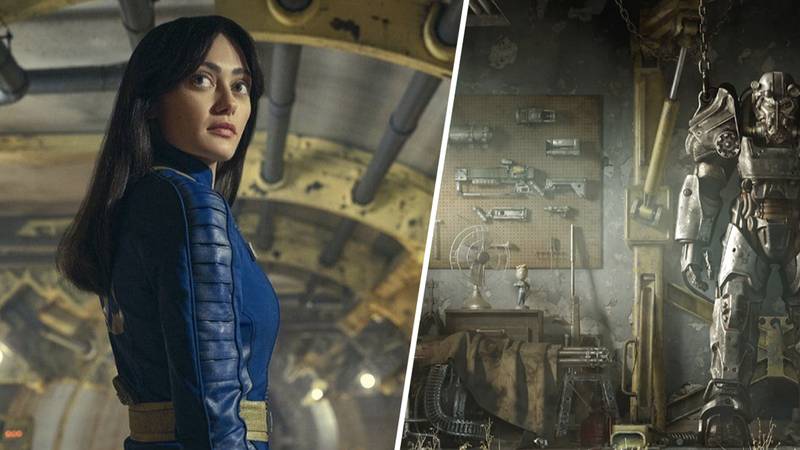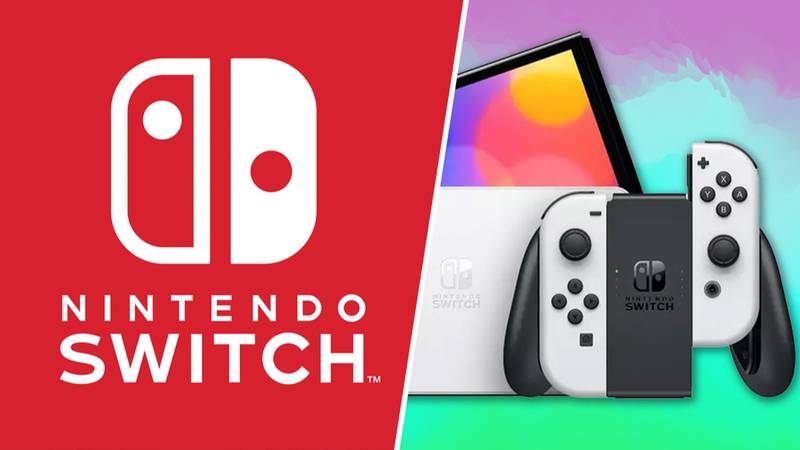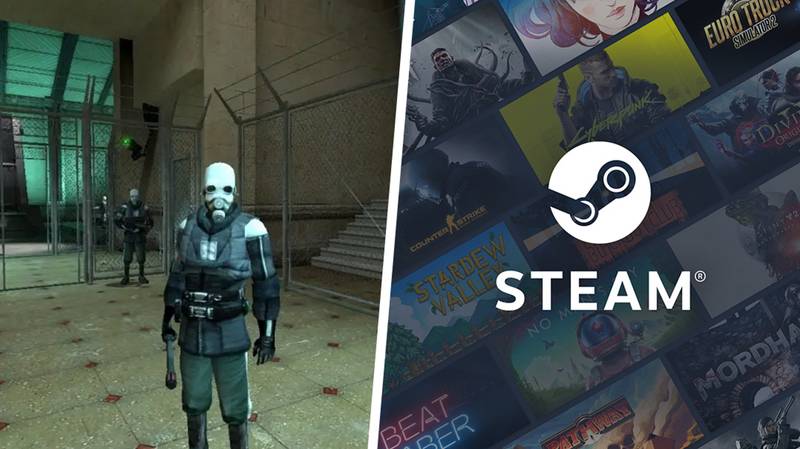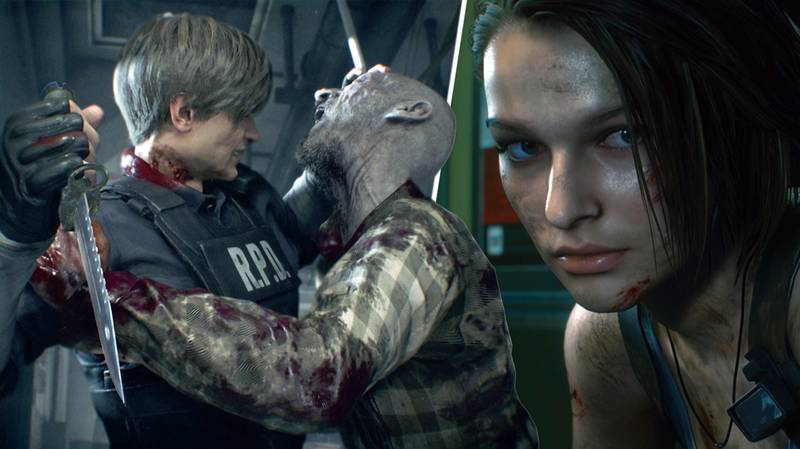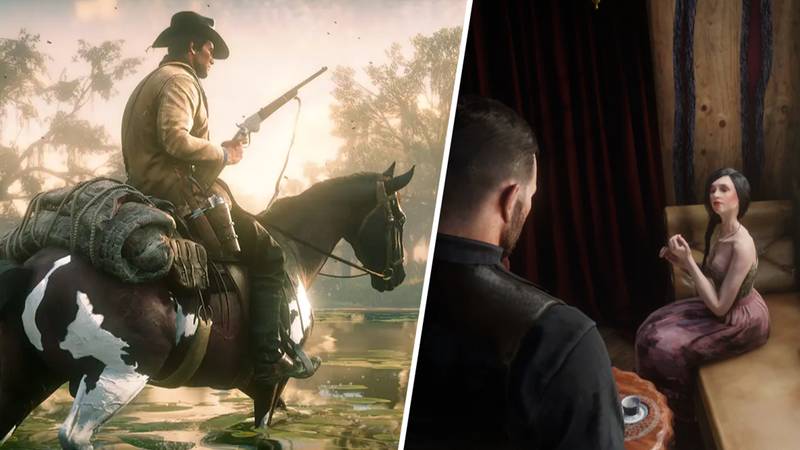Streets Of Rage At 30: How SEGA’s Classic Series Inspires Today’s Devs
Published
| Last updated

Featured Image Credit: SEGA
In the summer of 1991, SEGA unleashed a game on its 16-bit Mega Drive console that changed everything. And no, we're not talking about Sonic the Hedgehog.
While Sonic certainly altered the course of SEGA's fortunes when it sped into the gaming world in June 1991, replacing Alex Kidd as the company's platforming mascot, August 2 of that same year would see the debut of Streets of Rage, a side-scrolling beat 'em up that took on the arcade giants of the genre, and in many respects bettered them. Three playable characters, each with unique move-sets; two-player co-op gameplay; an array of weapons to help in the battle against big-bad Mr X's legions of henchmen; bosses that looks like they were plucked straight out of the (then) WWF and A Nightmare on Elm Street; and a Yuzo Koshiro soundtrack that tapped into the dance culture of the era, delivering propulsive techno and house beats to complement some epic smackdowns.
Loading…
Console and computer players were long used to seeing arcade giants significantly compromised for play-at-home ports. Capcom's Final Fight had been a coin-op hit in 1989, but its 1990 Super Famicom (SNES) conversion had to trim out a level, a playable character, and the two-player co-op option. SEGA's own Golden Axe of '89 received a decent Mega Drive/Genesis version, but naturally made compromises when it came to sound and vision. As ports went it was exceptional, but not quite the same game fans enjoyed in the arcade.
Streets of Rage - or Bare Knuckle in Japan - bucked at-the-time convention by being a side-scrolling, classically styled beat 'em up developed exclusively for console, bypassing the arcades completely. As such, there were no concessions to make, and nobody approached the game with expectations ready to be shattered. As such, first impressions were highly positive, and acclaim came quickly.
Directed by Noriyoshi Ohba - who'd previously worked on SEGA's Shinobi series and would go on to produce a number of Saturn titles, including Clockwork Knight - and programmed by Hiroshi Momota, whose past credits included Last Battle and Altered Beast, Streets of Rage was deemed essential by several critics, and immediately rushed to the top of best-ever titles for the Mega Drive. But 1991's game, subsequently ported to SEGA's Master System and Game Gear, was just the beginning.
Loading…
A superior 16-bit sequel followed in 1992, itself succeeded by a third mainline title in 1994. And after many years of silence, a quite-exceptional fourth game proper released in 2020, Streets of Rage 4 returning the original heroes of Axel Stone, Blaze Fielding and Adam Hunter to the spotlight in bone-crunching style - again supported by a fantastic soundtrack, largely from A Plague Tale: Innocence and Assassin's Creed IV: Black Flag - Freedom Cry composer Olivier Deriviere but also featuring all-new tracks from Koshiro himself.
Many Streets of Rage retrospectives have been written over the years, but this piece isn't here to go back to its roots as such. Rather, it's over to a selection of modern developers (and writers, and publishers) to explain their relationships with SEGA's series, and how it's inspired their own beat 'em up passion and driven them to create games and more that riff on the successes of a title that still manages to feel surprisingly fresh and exciting, 30 years on.
First Encounters
Cyrille Imbert, CEO and executive producer at Dotemu, developers of Streets of Rage 4:
I first played Streets of Rage on my Game Gear when I was around seven or eight years old. I used to play it a lot during trips to the south of France, in the back of my parent's car. Very fond memories!
Back in 2019, I met with Yuzo Koshiro and (co-composer on Streets of Rage 2) Motohiro Kawashima, we showed them Streets of Rage 4 at BitSummit and then I brought them back to the Kyoto train station in a taxi. It was a unique moment, and I was again picturing myself playing Streets of Rage in my parent's car in the '90s. That little kid could not have imagined that, 20 years later, he would be in a car, in Japan, with the people that made those games so great. I'll always be grateful to all the teams and people that made that moment possible (and it was captured, here).

Dave Cook, author of Go Straight, a history of beat 'em ups, published soon by Bitmap Books:
I first played Streets of Rage 2 in 1993, after my dad rented it for me from our local Ritz video rental shop. It was this wee shop, practically a cupboard, but it had shelves rammed with the hottest new movies and a surprisingly excellent Mega Drive library. Every Friday my dad would surprise me with a different game, and eventually one of those was Streets of Rage 2. It wasn't until after then that I checked out the first Streets of Rage on one of SEGA's old Mega Games collections. It might have been the one with The Revenge of Shinobi on it, I forget! (It was - Mega Games 2, also featuring Golden Axe.)
Axel is by far my favourite fighter of the original trilogy, and when it comes to the fourth game I've been converted to the DLC character, Estel, as you can really just jazz with her charge move and neutral special to fling enemies all around the screen. But yeah, Axel is my classic main, thanks in large part to his Ground Upper* forward-forward move. You can utterly melt the life bars of tougher enemies with it and even cancel some enemy attacks as it has priority. (*We all knew this as 'Grand Upper', until Yuzo Koshiro corrected us.)
Sebastian Garcia, developer of Fight'N Rage, a Streets of Rage-style beat 'em up released in 2017:
My favourite Streets of Rage game is the second one, and my favourite character to play is Blaze. She has a good combination of speed and strength, and is also the hardest character to master, I think, and that's a big plus if you enjoy challenges. I think that it's mandatory to play at least Streets of Rage 2 if you want to know how fun a beat 'em up can be. The game design in Streets of Rage 2 is probably amongst the best game design that I have ever seen.
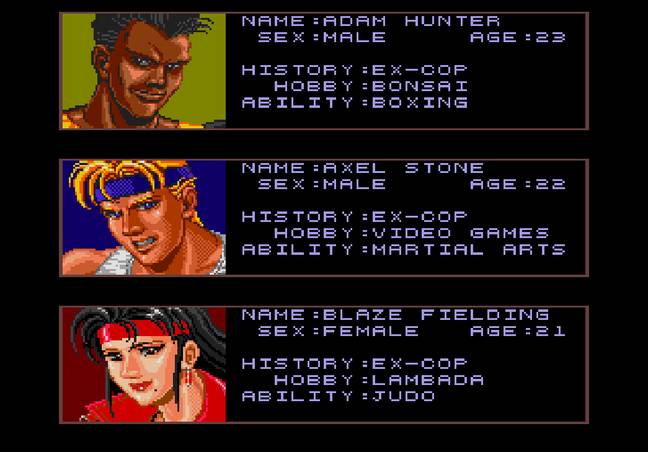
Shawn Alexander Allen, developer of Treachery in Beatdown City, a classic beat 'em ups-inspired game with an RPG twist, released in 2020:
I grew up without a game console, so I could only play what my friends had. Among my friends there was a cult of Nintendo, and the motto was "Genesis Sucks!" - a play on the Genesis DOES commercials - as a mantra, so everyone had Nintendo platforms and you were made fun of or berated for talking nice about the Genesis and its games. Elementary school kids can be cultish sometimes. Two of my closest friends had Double Dragon and Bad Dudes on NES, so I played those a bunch as a kid. I think they were my first beat 'em ups. Those games, with their apocalyptic, dangerous urban vibes resonated with my life in '80s New York City. The music and the art were unforgettable.
But to talk about Streets of Rage, you have to talk about Final Fight, which, as far as I can tell, started the concept of real character differentiation in a beat 'em up. Different weight and power classes that dictated gameplay styles was huge! Haggar and Guy played completely differently, which was amazing. And Cody was the stand in for the standard beat 'em up hero, so now there was a wider space for player expression.
Sam Dyer, creative director of Bitmap Books, publishers of Go Straight:
In the early '90s, I was a proud Amiga owner, which sadly wasn't blessed with decent scrolling beat 'em ups. My first Streets of Rage experience was playing co-op Streets of Rage 2 for hours on end with my friend Daniel who had a Mega Drive. I remember being really envious of the game, as it just felt so polished. The dance-inspired soundtrack and urban street fighting, mixed with the slick fighting action made it feel really grown up - an obvious appeal for a pair of 12 year olds!
Don't get me wrong, I wouldn't have swapped my Amiga with Monkey Island for anything, but it just wasn't designed for these types of games. Whenever I think of scrolling beat 'em ups, I instantly think of Streets of Rage 2 - it's iconic, and a masterpiece of game design.
The Arcade Experience, At Home
SG: I believe that Streets of Rage 2 could potentially not have been such a good game if it had been released in arcades before consoles. I think that could have conditioned the game to be unfairly hard to some extent, with intentionally bad game design practices such as intentionally badly placed collisions, or rules with arbitrary non-intuitive mechanics, in order to steal coins to players. However, fortunately it was released on consoles first, and the game design clearly was planned to be challenging, interesting and fair at same time. So, I think that console exclusivity release was a key factor to prioritising a lot of good practices, that finally helped Streets of Rage to be remembered as a great game that any kind of player can play and enjoy.
DC: There are a few reasons why Streets of Rage stood out from the pack. It felt so close to that idea of arcade gaming in the home, while other ports of cabinets felt really watered down by comparison. Also, more than any other side-scrolling beat 'em up, the classic Streets of Rage trilogy felt like it tapped into the vibe of '90s culture. This is thanks in big part to the trilogy's banging soundtrack.
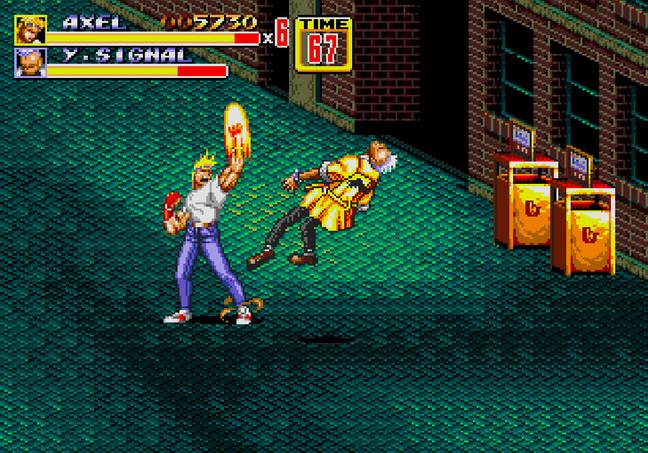
SAA: When it comes to arcade games with console ports, we used to get the short end of the stick a lot - as is very apparent by the SNES Final Fight port, which cut the third player, and was very plain looking compared to the arcade game. We also sometimes got an amazing gem, like the NES Double Dragon which forged its own path gameplay wise and distilled the arcade graphics and sound into something that was overall stronger. But usually, in order to get a quality beat 'em up on consoles, it needed to be a game built for the consoles.
Streets of Rage 2 benefited a lot by being a game you played at home. SEGA really figured out the perfect mix of arcade style play, with enough variety and depth to make the game a keeper. Also, the soundtracks benefited greatly from being on a console. Music wasn't super important in arcade games, simply because arcades were so loud. Also at the time a lot of arcade boards were very tinny and not well equipped to produce dynamic sounding music. You can listen to a lot of the older SEGA and Capcom arcade soundtracks and hear how they lacked that range. But you could really jam out to the Streets of Rage tunes, which not only had that range, but slapped in a way that affected music globally. I'd argue in some ways, the soundtrack is more important than the game itself.
The Music
DC: On that banging soundtrack, the first game was scored by Yuzo Koshiro and later titles included tracks with Motohiro Kawashima. In fact, the stage one music from Streets of Rage 2 is actually called 'Go Straight' which perfectly sums up the art of walking down seedy, urban streets and persevering straight ahead against seemingly impossible odds.
SAA: The music is, of course, a top-tier feature in the genre. I made a YouTube playlist of beat 'em up soundtracks and Streets of Rage soundtracks clearly standout against decades of other game music.
CI: The music by Koshiro-san was very different from what you heard in other games back in the days. It sounded like what you would hear in nightclubs, it was very cool.
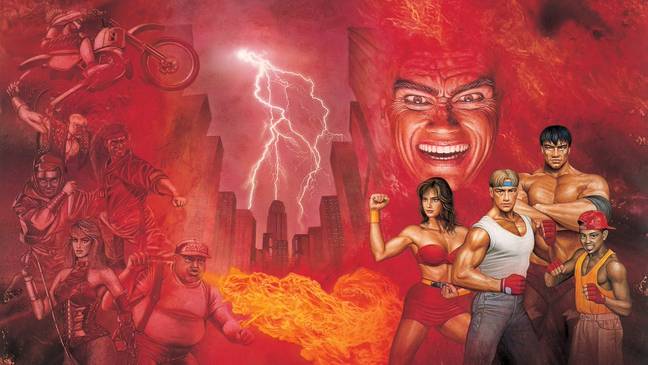
Angus Harrison, music journalist (interviewed by the author for VICE):
(On hearing 'Go Straight' from Streets of Rage 2) So that's the start of the game? Jesus. I'm struck by just how direct it is. It's like a big acid house tune. I was expecting something that used instrumentation or structures from club music - but that is basically a fast and hard acid house track. You can hear this strange conglomeration of different things in the track. It feels totally natural, but there are shades of Detroit techno coming through. There's also this Manchester, Hacienda-type acid house.
(On hearing 'Revenge of Mr X' from Streets of Rage 2) This has a lot more layers to it than what my head says there should be in an early 1990s video game. I know that electronic music and video games are closely linked, but I always thought that composers for games were just using, like, interesting synthesizers from the dance world. I didn't realise that anyone was making full-on dance tracks for a video game. Because that's basically what these are. This one has a real Detroit techno feeling to it.
That Special Something
CI: The overall production of Streets of Rage 2 was top-notch back in the day - the graphics, the sound effects, the music. The gameplay and the flow was very well tailored and thought through.
SAA: Player differentiation for me is one of the most important fundamentals of beat 'em ups. When I play as a grappler, I expect some awesome grapples and to feel really powerful. And when I play as a speedy character, I expect the game to feel very different. Streets of Rage 2 really leaned hard into this, which makes it super good.
Another aspect that made the Streets of Rage series exemplary was that as a console game, Streets of Rage 2 was an accomplishment from a game design and balance standpoint. While Final Fight 2 and 3 were, in my opinion, not good extrapolations of arcade beat 'em ups converted to consoles and felt limited, even with the innovations introduced, SoR2 and SoR3 maintained a certain quality and pacing that was on par with many arcade beat 'em ups, yet worked in the longer form setup.
The graphics, especially on the colour palette-limited Genesis - 52 colours compared to the SNES's 256 - are still, to this day, fantastic. The artists managed to make this colourful world filled with cartoony, vibrant, and memorable characters in a dark, wet, urban environment. It feels like a perfect distillation of '80s action movies.
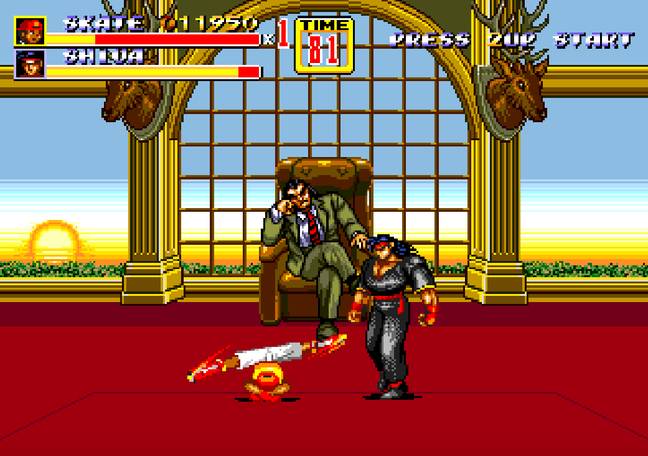
DC: The biggest reason I think Streets of Rage stood out is the combat. Keep in mind that the original SEGA Mega Drive controller only had three buttons, yet the second and third games in the Streets of Rage series had huge command lists. You had a neutral and directional special, a charge attack, a forward-forward attack, three aerial moves, up to three throws, a back attack and even the ability to land on your feet after being thrown to avoid damage - hold up and jump, it works every time!
That's a staggering achievement, and Streets of Rage 2 in particular was a shining example of pixel-perfect hit boxes, stunning visuals and many more elements that make it my favourite game of the genre and of all time. I think all of these things combined is why the series has endured for so long.
Streets of Rage's Influence and Legacy, Today
CI: There were actually many influences on Streets of Rage 4. Of course the original Streets of Rage games were a great influence, but also games like Guardian Heroes, Final Fight and other, more obscure beat 'em ups. Even fighting games like the Street Fighter series played a big role in the design of Streets of Rage 4, as Jordi Asensio, the game designer, is a huge fan of those games.
But nailing the original game feel, of those Streets of Rage games, was a priority. Once we had this, the idea was to get inspiration from different games and get the best ideas that would fit perfectly with the core gameplay of the SoR series. So adding new elements was quite important for us and something we were very excited about, because the possibilities were endless.
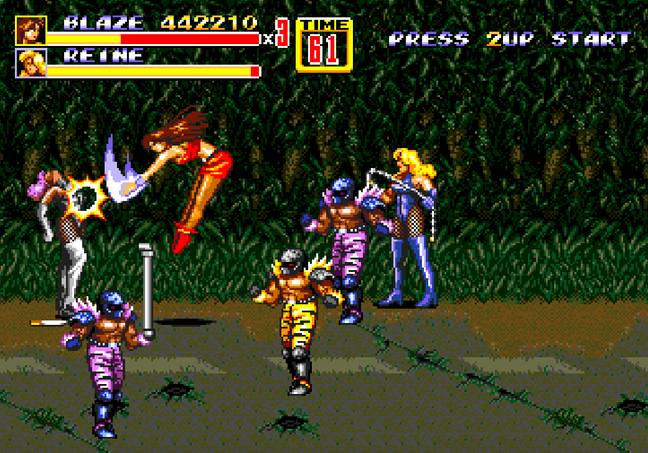
DC: I actually decided to start writing Go Straight after Streets of Rage 4 was announced. Like most fans of the side-scrolling genre, I had waited patiently since Streets of Rage 3 launched in 1994 to get a sequel, and here it was. It was finally happening, and it was blowing my mind. I also figured that game would be the fitting final entry in a chronological book about the genre's history, like the grand comeback of the old champion hungry to reclaim their title one last time.
Once I started researching and playing games for the book, I realised just how massive the genre is. It's a far bigger genre than I think many people realise, which is partly due to many games simply not being available to buy any more, or because other genres surpassed it. But if you're a fan of Streets of Rage, you can find a rich world of brawling out there with a little research. I've spent most of my life playing countless side-scrollers, but all of a sudden I was writing about rare curios from Japan like the Super Famicom game, UFO Kamen Yakisoban, a hilarious promotional brawler for the instant ramen company, Nissin, of Cup Noodles fame.
I even got to try some games that barely made a dent in the Western arcades thanks to their small cabinet runs, like Irem's outstanding Ninja Baseball Bat Man and the incredible Gaia Crusaders. The book also looks at some fringe titles that aren't true belt-scrolling like Streets of Rage, but they share enough DNA with it to warrant a mention, like Natsume's 2D SNES classic, The Ninja Warriors, and even 3D titles like SEGA's Die Hard Arcade and Core's Fighting Force - which was originally Streets of Rage 4 before SEGA pulled the licence.
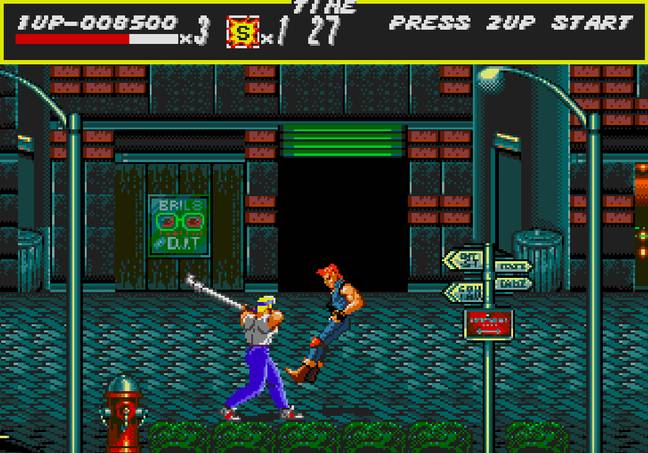
CI: Streets of Rage definitely should have been revived sooner. And while there's no SEGA console to play Streets of Rage 4 on today, our main goal was to bring back the franchise on every platform, so a lot of players would be able to discover or explore Wood Oak City again. It should have come back before, but that's exactly why we were thinking: "This needs to be done!"
SG: Fight'N Rage is inspired by games like Streets of Rage - and when I released it in 2017, I was really amazed. I was pretty sure that it had potential to be a niche success, but I did not expect such a positive reception. A lot of people loved the game, and they talked a lot about it. The reviews were very positive and rapidly a lot of people started to make videos about it - even nowadays, there are new videos daily. That's led a lot of people to discover Fight'N Rage, even four years after its release! Looks like there were a lot of players, like me, that were waiting for a new old-school beat'em up experience.
SAA: I'm not sure about the reception and legacy of the Streets of Rage games today. SEGA's priorities and focus switches up a lot. Their biggest games right now are the Yakuza series, which I feel like are a general culmination of decades of work. I'd love to see a Streets of Rage-skinned Yakuza game. (There kind of was, with Streets of Kamurocho, but it was a promotional release only available for a limited time.) I wonder what shifted at SEGA to get them to bring back SoR in a way that Capcom has been avoiding with Final Fight.
With Treachery in Beatdown City, I decided specifically to use the original NES Double Dragon as a style constraint, with a focus on making the backgrounds a lot more varied and detailed. "Retro", but modern. Much like in the way a person might paint an expressionist painting today.
When I started making Treachery in Beatdown City, it was supposed to be "the best beat 'em up". As we kept working on it, it became clear we needed to switch things up, for our own sake.
I'd been catching up with the genre I loved and breaking down what I liked, what I loved, what I didn't like, and it led me to want to do something different. Which didn't always resonate with folks, but it made me happy, especially because I took a lot of inspiration from Yoshihisa Kishimoto's design philosophy (on games like the Kunio-kun franchise, including River City Ransom, and Double Dragon series) from decades prior. River City Ransom was an attempt at adding a lot to the genre: RPG stats, learning moves via experience, randomised enemy placement, exploring a nonlinear environment, physics-based combat for weapons. These were all super new when they were added. If it was made now, it'd be a roguelike physics game.
While there's still some room for simpler beat 'em ups, and folks claim to want them, they usually get dragged through the mud by reviews and disappear into obscurity. And the genre seems to have a big rose-tinted glasses problem. Modern fans don't seem to remember what the older games played like, or the depth to the combat - or lack thereof. This can often be seen in design choices and reviews of modern beat 'em ups.

SG: When I was developing Fight'N Rage, I was strongly focused on the one-sitting gameplay experience - like you had with classic beat 'em ups. I think that's the most desired experience that a lot of players like me want when playing video games of this genre.The idea behind Fight'N Rage is that people learn to enjoy mastering the game. I needed to give the players a reason to beat harder challenges every time they return to it. That's the main reason why I included a large amount of unlockables - even if you already have beaten Fight'N Rage, you will have a lot of reasons to play it again and improve your skills on it.
SD: There is so much nostalgia associated with scrolling beat 'em ups. Whether it's memories of playing four-player The Simpsons at the local swimming baths with friends, or warm fuzzy recollections of Streets of Rage with childhood friends, legs crossed, huddled around a tiny CRT. It could be because they were always best played with more than one player, so remembered fondly because of that social aspect.
I also think that unlike some genres, most scrolling beat 'em ups have aged really well. Maybe it's the excellent playability that means that even today, most can be played without feeling dated. I also think they're more accessible than most 1-vs-1 fighters that have complicated button combos. My five-year-old son and I quite often play The Simpsons and Turtles. They don't feel prehistoric to him like some games from that era and can easily be picked up and played for a quick blast.
The Go Straight book covers over 200 scrolling beat 'em ups. There are titles that some people may not be familiar with, as well as Japan-exclusive inclusions. I think the book strikes the right balance between household titles and lesser known ones, therefore offering something for everyone. The book is also written as a 'guide', so instead of being a pure history of the genre, it contains, hints, level guides and strategies.
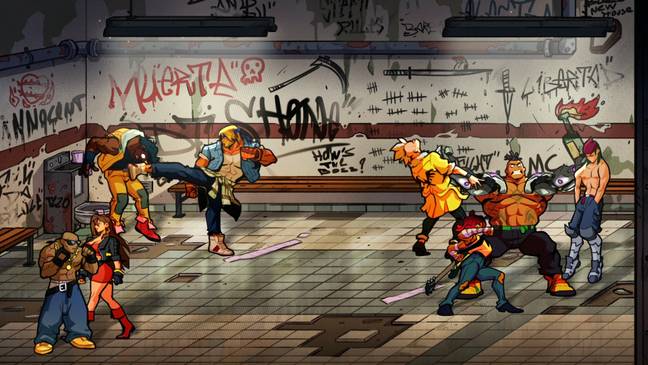
Streets of Rage 4, and the Beat 'Em Up Future
CI: It was an awesome feeling to get the go ahead to make Streets of Rage 4. We had a couple of months to prepare psychologically and we were already making plans but when the deal was signed, right in front of me, it was quite different. Things were getting serious and we knew we had one shot at this, so we had to give it our best.
SG: I have played Streets of Rage 4, and I love it. I think it's a good sequel, and feels more like a follow-up to SoR2, instead of a direct SoR3 sequel, because it lacks some key SoR3 features, like story ramifications and some character's base movements, like vertical evasion and a run capability for each character. However, I love how they focused the gameplay on action and not introducing RPG elements, even when there's a massive mainstream public that usually love and expect those inclusions. They kept the game as a pure beat 'em up in 2020, and man, I think that's something risky for a big company. But I think they made a great game, and the reviews confirm that.
I have plans to make a Fight'N Rage sequel in the future. However, at this moment, I'm more focused on developing a different game while I'm improving my own framework and tools.
SAA: Of course I played it! I buy most new beat 'em ups, it's a genre I feel sorta obligated to stay in the know on. Playing so many of them for research was my life for many years. I love to play and dissect beat 'em ups, but it's rare that I fall in love with new ones any more. While I enjoyed parts of Streets of Rage 4, and I legit love the new Black heroes they added, as well as appreciating the return of Adam Hunter from the original game, it didn't wow me.
I just don't get why so many beat 'em up games these days focus so hard on juggles. It makes for cool highlight videos, but I find it obnoxious from a balance standpoint - enemies are given extra HP because they are expecting you to juggle them. Ever since Castle Crashers, which incorporated an 'aerial rave' design, it just became the go-to for many beat 'em up games to feature action that is more akin to a Marvel Vs. Capcom game, or Devil May Cry, instead of the more grounded approach of the games I prefer.
I went back and booted up SoR 2 and 3 immediately after beating 4 because I wondered if I had somehow missed a transition in gameplay... And sure enough,they just felt better to get through, to me, because they weren't focused on prolonging the experience through juggles.
It can seem somewhat hypocritical since I designed a game where the fights with each enemy are much longer than a standard beat 'em up game - but my decisions came from making the fights more personal, and more like an actual fight. When you throw three or four of the same model, palette-swapped enemies at me, and I have to figure out how to get them all grouped up to juggle them effectively - that just isn't my bag, and I wish games would just stop focusing on that.
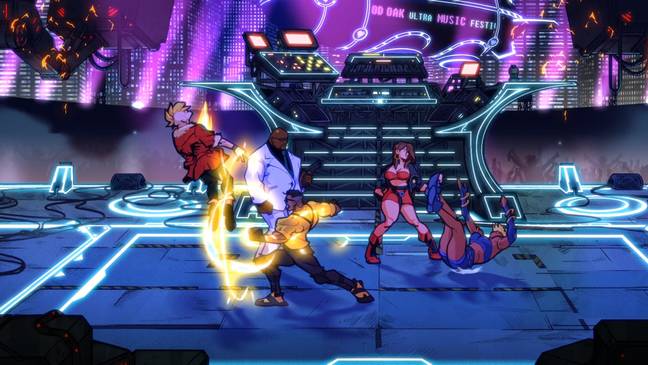
DC: The most impressive thing about Streets of Rage 4 is that you can absolutely ignore all the new moves and combo system, then choose to play just using the same moves the characters had in Streets of Rage 2. It still works, and the fact that Dotemu, (co-developers) Guard Crush Games and Lizardcube worked in harmony to create something that feels old and new without falling apart, is simply a staggering achievement. The modern tweaks make it feel like a very different game, especially when you're trying not to blink during a 100-move combo, but the familiar foundation is always there to remind you that yes, you are playing a classic Streets of Rage experience.
I think if SEGA had put out a fourth game in the late '90s as another 2D brawler with incredible pixel animation close to that seen in Street Fighter III, then I think the world would have accepted that and had their minds blown. But as Go Straight hopefully shows, as long as the core fundamentals of the beat 'em up genre are rock solid, then the extra mechanics on top should hopefully just make a great thing even better.
---
Thanks to everyone for giving up their time to talk Streets of Rage and beat 'em up history.
Treachery in Beatdown City is available now and can be found on Steam here.
Fight'N Rage is available now on Steam and consoles.
Streets of Rage 4 is available now for PC and consoles. A DLC-complete edition releases on September 28, 2021. Find GAMINGbible's review here.
Go Straight will be published in February 2022 by Bitmap Books.
Topics: Sega, Interview, Retro Gaming






